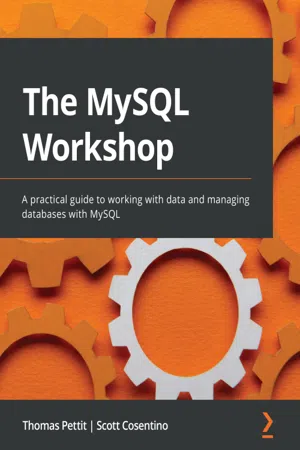
- 726 pages
- English
- ePUB (mobile friendly)
- Available on iOS & Android
The MySQL Workshop
About this book
Learning MySQL just got a whole lot easier, thanks to this hands-on workshop, complete with simple explanations, engaging examples, and realistic exercises that focus on helping you to build and maintain databases effectivelyKey Features• Learn how to set up and maintain a MySQL database• Run SQL queries to create, retrieve, and manipulate data• Use MySQL effectively with common business applications such as Excel and MS AccessBook DescriptionDo you want to learn how to create and maintain databases effectively? Are you looking for simple answers to basic MySQL questions as well as straightforward examples that you can use at work? If so, this workshop is the right choice for you.Designed to build your confidence through hands-on practice, this book uses a simple approach that focuses on the practical, so you can get straight down to business without having to wade through pages and pages of dull, dry theory.As you work through bite-sized exercises and activities, you'll learn how to use different MySQL tools to create a database and manage the data within it. You'll see how to transfer data between a MySQL database and other sources, and use real-world datasets to gain valuable experience of manipulating and gaining insights from data. As you progress, you'll discover how to protect your database by managing user permissions and performing logical backups and restores.If you've already tried to teach yourself SQL, but haven't been able to make the leap from understanding simple queries to working on live projects with a real database management system, The MySQL Workshop will get you on the right track.By the end of this MySQL book, you'll have the knowledge, skills, and confidence to advance your career and tackle your own ambitious projects with MySQL.What you will learn• Understand the concepts of relational databases and document stores• Use SQL queries, stored procedures, views, functions, and transactions• Connect to and manipulate data using MS Access, MS Excel, and Visual Basic for Applications (VBA)• Read and write data in the CSV or JSON format using MySQL• Manage data while running MySQL Shell in JavaScript mode• Use X DevAPI to access a NoSQL interface for MySQL• Manage user roles, credentials, and privileges to keep data secure• Perform a logical database backup with mysqldump and mysqlpumpWho this book is forThis book is for anyone who wants to learn how to use MySQL in a productive, efficient way. If you're totally new to MySQL, it'll help you get started or if you've used MySQL before, it'll fill in any gaps, consolidate key concepts, and offer valuable hands-on practice. Prior knowledge of simple SQL or basic programming techniques will help you in quickly grasping the concepts covered, but is not necessary.
Frequently asked questions
- Essential is ideal for learners and professionals who enjoy exploring a wide range of subjects. Access the Essential Library with 800,000+ trusted titles and best-sellers across business, personal growth, and the humanities. Includes unlimited reading time and Standard Read Aloud voice.
- Complete: Perfect for advanced learners and researchers needing full, unrestricted access. Unlock 1.4M+ books across hundreds of subjects, including academic and specialized titles. The Complete Plan also includes advanced features like Premium Read Aloud and Research Assistant.
Please note we cannot support devices running on iOS 13 and Android 7 or earlier. Learn more about using the app.
Information
Section 1: Creating Your Database
- Chapter 1, Background Concepts
- Chapter 2, Creating a Database
- Chapter 3, Using SQL to Work with a Database
- Chapter 4, Selecting, Aggregating, and Applying Functions
Chapter 1: Background Concepts
- Introducing databases
- Exploring MySQL
- Exercise 1.01: Organizing data in a relational format
- Exploring MySQL architecture
- Storage engines (InnoDB and MyRocks)
- Data modeling
- Normalization
- Activity 1.01: Creating an optimized table for an employee project
Introducing databases
Database architecture


Table of contents
- The MySQL Workshop
- Contributors
- Preface
- Section 1: Creating Your Database
- Chapter 1: Background Concepts
- Chapter 2: Creating a Database
- Chapter 3: Using SQL to Work with a Database
- Chapter 4: Selecting, Aggregating, and Applying Functions
- Section 2: Managing Your Database
- Chapter 5: Correlating Data across Tables
- Chapter 6: Stored Procedures and Other Objects
- Chapter 7: Creating Database Clients in Node.js
- Chapter 8: Working with Data Using Node.js
- Section 3: Querying Your Database
- Chapter 9: Microsoft Access – Part 1
- Chapter 10: Microsoft Access – Part 2
- Chapter 11: MS Excel VBA and MySQL – Part 1
- Chapter 12: Working With Microsoft Excel VBA – Part 2
- Section 4: Protecting Your Database
- Chapter 13: Getting Data into MySQL
- Chapter 14: Manipulating User Permissions
- Chapter 15: Logical Backups
- Appendix
- Other Books You May Enjoy